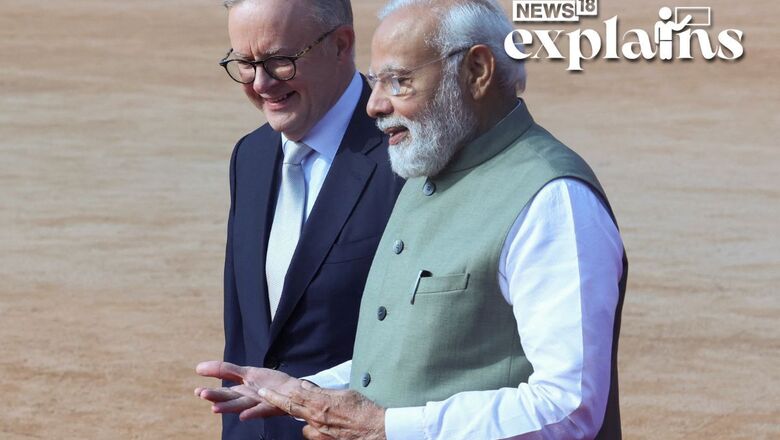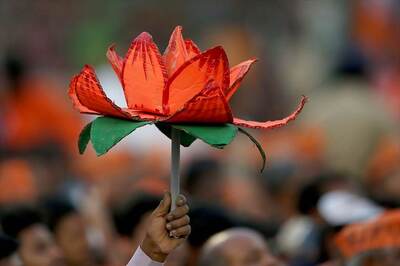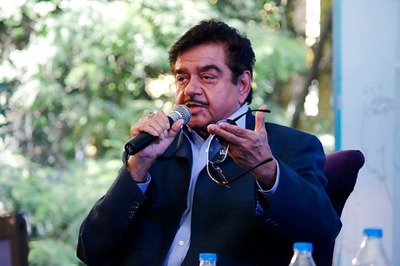
views
Prime Minister Narendra Modi on Friday held wide-ranging talks with his Australian counterpart Anthony Albanese with a focus on boosting overall bilateral engagement in areas of trade and investment, defence and critical minerals. The PM also held a presser with his Australian counterpart, who arrived in Delhi on Thursday evening after concluding his engagements in Ahmedabad and Mumbai.
Addressing the joint press meet with PM @AlboMP. https://t.co/dsbdtzKsEG— Narendra Modi (@narendramodi) March 10, 2023
Amid the high-key visit and meetings, a look at India-Australia ties:
“Australia and India are great friends. We are partners and we are building that partnership even stronger each and every day,” Albanese said after he was accorded a ceremonial welcome at the Rashtrapati Bhavan this morning.
The Australian prime minister said Canberra wants to cooperate with India to build a stronger relationship in areas of culture, economic relations as well as security.
“We are competing on the cricket field to be world’s best but together we are building a better world,” he said.
Days ahead of his visit to India, Albanese said a stronger India-Australia partnership is good for regional stability and that it also means more trade and investment.
It is his first visit to India after becoming the prime minister in May last year. The last visit to India by an Australian prime minister was in 2017.
India-Australia Ties on Upswing
Albanese’s visit comes after a series of high-level engagements and exchange of ministerial trips between two sides in 2022 and in 2023. External Affairs Minister S Jaishankar travelled to Australia on February 18 while his counterpart Penny Wong visited New Delhi from February 28 to March 3.
Delighted to call on Prime Minister @AlboMP of Australia this morning. His visit and today’s Annual Summit will take our ties to a higher level. pic.twitter.com/ixm8Mn94n3
— Dr. S. Jaishankar (@DrSJaishankar) March 10, 2023
The India-Australia bilateral economic ties are on an upswing, PTI reported, adding that the Economic Cooperation Trade Agreement (ECTA) has entered into force from December 2022.
It is the first free trade agreement signed by India with any developed country in a decade.
About the ECTA
The two countries signed last year a free trade agreement called the Economic Cooperation and Trade Agreement (ECTA), the first signed by India with a developed country in a decade.
However, a much larger Comprehensive Economic Cooperation Agreement has been stuck in negotiations for over a decade. Discussions began in 2011 but were suspended in 2016 as the talks were gridlocked.
The negotiations resumed in 2021 but a deal has yet proved to be elusive. Australian Minister for Trade and Tourism Don Farrell is a part of Albanese’s delegation and the visit is expected to provide an opportunity to hasten the ambitious deal.
The ECTA provides zero-duty access to 96% of India’s exports to Australia and gives about 85% of Australia’s exports zero-duty access to the Indian market, as per reports. The aim of the trade agreement is to provide a push to bilateral trade in goods and services to $45-50 billion over five years, up from around $27 billion, and generate over one million jobs in India, a government estimate said.

It covers almost all tariff lines dealt in by India and Australia respectively. While India will benefit from preferential market access given by Australia on 100% of its tariff lines, Australia gets preferential access to on over 70% of its tariff lines.
Indian graduates from STEM (Science, Technology, Engineering and Mathematics) will also be granted extended post-study work visas under the agreement.
Bilateral trade was $27.5 billion (one billion = 100 crore) in 2021. Australia is the 17th largest trading partner of India and India is Australia’s ninth largest trading partner, according to official data.
With ECTA, there is potential for bilateral trade to reach around $50 billion in five years.
India is one of the top sources of skilled immigrants to Australia. The Indian community in Australia continues to grow in size and importance.
The cooperation in education is also on an upward trajectory.
QUAD and China
The three-day visit by Albanese, came days ahead of a visit by Japanese PM Fumio Kishida, another member of the QUAD grouping that seeks to counter China’s growing domination in the Indo-Pacific region.
Quad includes the United States and India besides Australia and Japan. Australia is due to host a Quad leaders summit in Sydney later this year.
#WATCH | Australian PM Anthony Albanese inside the cockpit of LCA onboard INS Vikrant, off Mumbai coast pic.twitter.com/hXqSqPIHcF— ANI (@ANI) March 9, 2023
During his visit to India’s first indigenous aircraft carrier, INS Vikrant, Albanese said, “We (India and Australia) both depend on free and open access to sea lanes in the Indo-Pacific for our trade and economic well-being. And we share an unwavering commitment to upholding the rules-based international order and ensuring the Indo-Pacific is open, inclusive and prosperous.”
He made those comments
His comments came against the firm Chinese push for greater maritime influence in the far seas.
Historical Perspective
The bilateral relationship between India and Australia is based on common ideals such as “pluralistic, Westminster-style democracies, Commonwealth traditions, increased economic engagement, and increasing high-level interaction,” as per the High Commission of India, Canberra.
Longstanding people-to-people contacts, an increase in Indian students going to Australia for higher education, burgeoning tourism, and sporting links, particularly in cricket and hockey, have all contributed to further strengthening bilateral relations between the two countries, the website reads.
As per the High Commission, recent years have seen India-Australia ties charting a “whole new trajectory of transformational growth.”
“With greater convergence of views on various international issues such as international terrorism and shared approach to rules-based order in the Indo-Pacific region, the two great democracies of the region have expanded their bilateral relationship into global partnerships in plurilateral formats, including the Quad,” it states.
India and Australia began their ties after the European settlement in Australia from 1788. “All trade to and fro from the penal colony of New South Wales was controlled by the British East India Company through Kolkata. India and Australia established diplomatic relations in the pre-Independence period, with the establishment of India Trade Office in Sydney in 1941. The end of the Cold War and simultaneously India’s decision to launch major economic reforms in 1991 provided the first positive move towards development of closer ties between the two nations. With the passage of time, the relationship gained momentum towards a strategic relationship, alongside the existing economic engagement,” the High Commission website states.
In 2020, Australia and India upgraded their bilateral relationship to Comprehensive Strategic Partnership (CSP) from ‘Strategic Partnership’ in 2009. An array of institutional mechanism has helped promote bilateral co-operation over the years and such mechanisms include high level visits, Annual Meetings of Prime Ministers, Foreign Ministers’ Framework Dialogue, 2+2 Defence and Foreign Ministers’ Dialogue, Joint Trade & Commerce Ministerial Commission, Defence Policy Talks, Australia-India Education Council, Defence Services Staff Talks, Energy Dialogue, JWGs on different issues etc., the website says.
With inputs from PTI, Reuters
Read all the Latest Explainers here


















Comments
0 comment